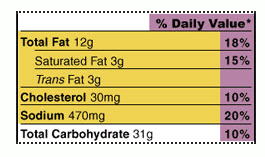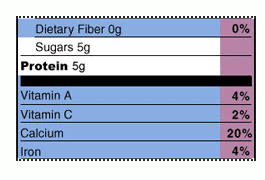UNDER THE MICROSCOPE

The Nutrition Facts Label - Your Healthy Eating Tool
So, how many calories are you eating each day? How much fat? Gettin’ enough vitamins, calcium, and iron? The Nutrition Facts label is the way you can tell. Here’s a crash course.
 |
The top of the label tells you the size of one serving, and how many servings are in the package. What matters here? Check the size of a serving. Is the portion you choose actually two, three, or four servings? Then double, triple, or quadruple the , vitamins, etc. you see on the rest of the label. |
 |
This section is about calories, and calories from fat. What matters here? Regularly eating more calories than the body uses leads to having extra body weight to lug around. A rule of thumb for choosing foods—40 calories per serving means the food is low in calories, 100 calories/serving is moderate, and 400 or more is high. |
 |
Next come nutrients that Americans typically eat plenty (or too much!) of. What matters here? A healthy eating style limits , , and . The % Daily Value column is your "cheat sheet." If the column shows 5% or less, the food is low in fat, or cholesterol, or sodium. If the column shows 20% or more, the food is high in fat, cholesterol, or sodium. |
 |
This part lets you zero in on key nutrients we all need. What matters here? Are the foods you eat delivering 100% of the fiber, vitamins, calcium, and iron you need? Remember that foods without labels (like fresh fruits and veggies) count too! |
 |
Last, the footnote. What matters here? The footnote provides a handy daily cheat sheet on how much you should be aiming for overall in terms of fat, cholesterol, sodium (salt) , carbohydrates, and fiber. This part of the label is the same on every food. (To make it easy for you, most kids aged 9-13 need about 2,000 calories per day. |
- Page last reviewed: May 9, 2015
- Page last updated: May 9, 2015
- Content source:



 ShareCompartir
ShareCompartir